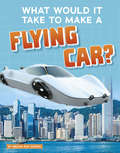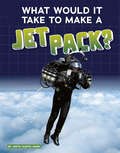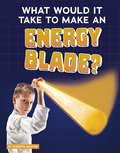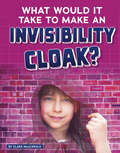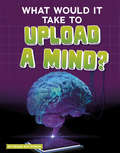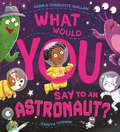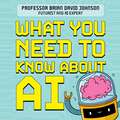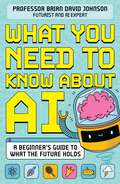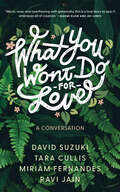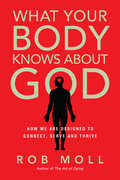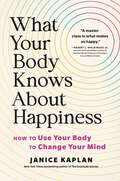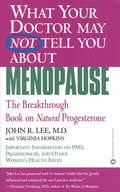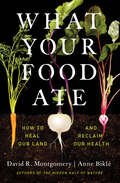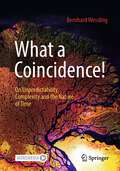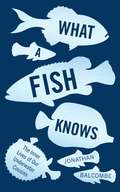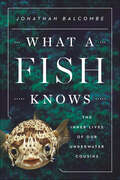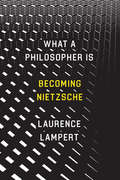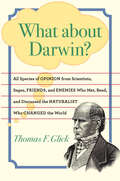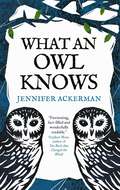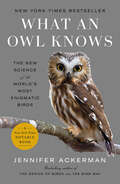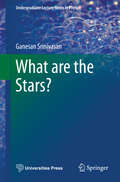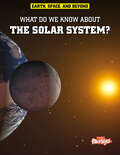- Table View
- List View
What Would It Take to Make a Flying Car? (Sci-Fi Tech)
by Megan Ray DurkinIn science fiction, flying cars let people soar over traffic jams and get to where they're going quickly. How could a vehicle that both flies and drives be created? Scientists' ideas for this involve futuristic materials and technology from drones. Discover the science and technology behind what it would take to make a real-life flying car!
What Would It Take to Make a Hoverboard? (Sci-Fi Tech)
by Anita Nahta AminIn science fiction, hoverboard users glide above sidewalks on machines that look like skateboards with no wheels. How could one of these floating boards be created? Scientists have some ideas, which include using powerful magnets. Discover the science and technology behind what it would take to make a real-life hoverboard!
What Would It Take to Make a Jet Pack? (Sci-Fi Tech)
by Anita Nahta AminIn science fiction, jet packs let people zoom through the air at high speeds. Discover the science and technology behind what it would take to make a real-life jet pack!
What Would It Take to Make an Energy Blade? (Sci-Fi Tech)
by Roberta BaxterIn science fiction, energy blades are weapons or tools that look like glowing swords. How could one of these powerful devices work? Scientists have some ideas, which include using plasma. Discover the science and technology behind what it would take to make a real-life energy blade!
What Would It Take to Make an Invisibility Cloak? (Sci-Fi Tech)
by Clara MacCaraldIn science fiction, invisibility cloaks let their users vanish from sight and sneak around unnoticed. How could one of these stealthy pieces of clothing work? Scientists have some ideas, which involve bending light. Discover the science and technology behind what it would take to make a real-life invisibility cloak!
What Would It Take to Upload a Mind? (Sci-Fi Tech)
by Megan Ray DurkinIn science fiction, people upload their minds into computers for them to be stored. How could this futuristic way of preserving the mind work? Scientists have some ideas, which involve mapping the brain cell by cell. Discover the science and technology behind what it would take to upload a mind in real life!
What Would You Say to an Astronaut?
by Adam Guillain Charlotte GuillainTime is running out and Astronaut Grace and her trusty canine sidekick, Jojo, need to get to Planet Woof fast! But first they must navigate their way through an intergalactic funfair, avoid a collision with a bus full of aliens, and win a lightning-fast space race, all with a few extra passengers on board.With hilariously nonsensical questions and answers, unpredictable space drama and plenty to spot on every page, this picture book is huge fun to read aloud and is sure to become a family favourite.
What You Need to Know About AI: A beginner’s guide to what the future holds
by Brian David JohnsonThe only book you need on AI - for all curious, fact-gobbling kids age 7+.What actually is AI? Will it take over the world? And one day, will it tidy your bedroom...? In this beginner's guide, learn everything you need to know about AI, from how it helps us discover epic stuff up in space or under the sea, whether it will help you build your very own dinosaur, and why, it won't actually help you write your homework! Written by AI expert and Futurist, Brian David Johnson, you will learn what AI is, where it came from, and how it's already being used in the world of sport, space, medicine, animals and more. You will discover AI's amazing possibilities that might shape the future. And along the way, you'll learn super cool facts, bust some myths, and gain a balanced and informed view on the biggest topic of our time.Designed with fun line illustrations throughout.
What You Need to Know About AI: A beginner’s guide to what the future holds
by Brian David JohnsonThe only book you need on AI - for all curious, fact-gobbling kids.What actually is AI? Will it take over the world? And one day, will it tidy your bedroom . . .? In this beginner's guide, learn everything you need to know about AI, from how it helps us discover epic stuff up in space or under the sea to whether it might help you build your own dinosaur.With AI expert and futurist Brian David Johnson, discover what AI is, where it came from, the incredible ways it's being used today and how it might shape and reimagine your future. Learn that AI is just software and that it won't replace human creativity or imagination, but it could help us do some really cool things. And uncover amazing facts, myth busters and insight from experts around the world!This book offers a balanced, expert and fascinating view on the biggest topic of our time. Designed with fun illustrations throughout.
What You Won’t Do For Love: A Conversation
by David Suzuki Ravi Jain Tara Cullis Miriam FernandesWhat if we could love the planet as much as we love one another? "Warm, wise, and overflowing with generosity, this is a love story so epic it embraces all of creation. Yet another reminder of how blessed we are to be in the struggle with elders like David and Tara.” – Naomi Klein and Avi Lewis What You Won’t Do for Love is an inspiring conversation about love and the environment. When artist Miriam Fernandes approaches the legendary eco-pioneer David Suzuki to create a theatre piece about climate change, she expects to write about David’s perspective as a scientist. Instead, she discovers the boundless vision and efforts of Tara Cullis, a literature scholar, climate organizer, and David’s life partner. Miriam realizes that David and Tara’s decades-long love for each other, and for family and friends, has only clarified and strengthened their resolve to fight for the planet. What You Won’t Do for Love transforms real-life conversations between David, Tara, Miriam, and her husband Sturla into a charmingly novel and poetic work. Over one idyllic day in British Columbia, Miriam and Sturla take in a lifetime of David and Tara’s adventures, inspiration, and love, and in turn reflect on their own relationships to each other and the planet. Revealing David Suzuki and Tara Cullis in an affable, conversational, and often comedic light, What You Won’t Do For Love asks if we can love our planet the same way we love one another.
What Your Body Knows About God: How We Are Designed to Connect, Serve and Thrive
by Rob MollHave you ever had an experience where you felt particularly aware of God? If God is real, and we are created in God's image, then it makes sense that our minds and bodies would be designed with the perceptive ability to sense and experience God. Scientists are now discovering ways that our bodies are designed to connect with God. Brain research shows that our brain systems are wired to enable us to have spiritual experiences. The spiritual circuits that are used in prayer or worship are also involved in developing compassion for others. Our bodies have actually been created to love God and serve our neighbors. Award-winning journalist Rob Moll chronicles the fascinating ways in which our brains and bodies interact with God and spiritual realities. He reports on neuroscience findings that show how our brains actually change and adapt when engaged in spiritual practices. We live longer, healthier, happier and more fulfilling lives when we cultivate the biological spiritual capacity that puts us in touch with God. God has created our bodies to fulfill the Great Commandment; we are hardwired to commune with God and to have compassion and community with other people. Moll explores the neuroscience of prayer, how liturgy helps us worship, why loving God causes us to love others, and how a life of love and service leads to the abundant life for which we were created. Just as our physical bodies require exercise to stay healthy, so too can spiritual exercises and practices revitalize our awareness of God. Heighten your spiritual senses and discover how you have been designed for physical and spiritual flourishing.
What Your Body Knows About Happiness: How to Use Your Body to Change Your Mind
by Janice KaplanHappiness isn't just a state of mind. It's also a state of body.Standing straight can give you a shot of confidence and forcing a smile might improve your mood. But do you know why? We generally believe that the brain is the big computer telling our bodies how to respond, but new research shows that the system often works in reverse. Your body reacts first, and your brain then interprets the physical signals. As you walk by a dark alley, your heart starts pounding and only then does your brain get the message: I'm scared! The body can also send messages about positive emotions, allowing you to experience more happiness, love, and joy.Based on groundbreaking research and expert opinions, What Your Body Knows About Happiness will teach you:How to use your body to spark your creativityHow to find joy through your sensesHow changing your environment can improve your moodThe unexpected powers of diet, exercise, and sexThe ways your brain can resolve bodily painHow to create optimism through your bodyIn What Your Body Knows About Happiness, Janice Kaplan, the New York Times bestselling author of The Gratitude Diaries, explores the startling new evidence showing that our feeling bodies are often smarter than our thinking minds. Talking to experts in a wide range of fields, she brings her distinctive brand of conversation, humor, and storytelling to scientific research, drawing unexpected links that reveal the power of body-mind connections. You'll also get tips and strategies for knowing your body in a whole new way—leading to greater happiness and pleasure every day.
What Your Doctor May Not Tell You About(TM): Menopause
by Virginia Hopkins John R. LeeArguing that giving estrogen replacement therapy to women after menopause is medically the wrong thing to do, Lee suggests that natural progesterone can prevent most of the unpleasant side effects of menopause, including osteoporosis and weight gain.
What Your Doctor May Not Tell You About(TM): The Breakthrough Book on Natural Progesterone
by Virginia Hopkins John R. LeeA guide to alternative therapies for managing menopause.
What Your Food Ate: How to Heal Our Land and Reclaim Our Health
by David R. Montgomery Anne BikléAre you really what you eat? David R. Montgomery and Anne Biklé take us far beyond the well-worn adage to deliver a new truth: the roots of good health start on farms. What Your Food Ate marshals evidence from recent and forgotten science to illustrate how the health of the soil ripples through to that of crops, livestock, and ultimately us. The long-running partnerships through which crops and soil life nourish one another suffuse plant and animal foods in the human diet with an array of compounds and nutrients our bodies need to protect us from pathogens and chronic ailments. Unfortunately, conventional agricultural practices unravel these vital partnerships and thereby undercut our well-being. Can farmers and ranchers produce enough nutrient-dense food to feed us all? Can we have quality and quantity? With their trademark thoroughness and knack for integrating information across numerous scientific fields, Montgomery and Biklé chart the way forward. Navigating discoveries and epiphanies about the world beneath our feet, they reveal why regenerative farming practices hold the key to healing sick soil and untapped potential for improving human health. Humanity’s hallmark endeavors of agriculture and medicine emerged from our understanding of the natural world—and still depend on it. Montgomery and Biklé eloquently update this fundamental reality and show us why what’s good for the land is good for us, too. What Your Food Ate is a must-read for farmers, eaters, chefs, doctors, and anyone concerned with reversing the modern epidemic of chronic diseases and mitigating climate change.
What a Coincidence!: On Unpredictability, Complexity and the Nature of Time
by Bernhard WesslingHow does chance enter our world? And why is so much not predictable?In an understandable, exciting and amusing narrative, the author takes us into the world of chemistry, quantum physics and biology. Touching on astronomy and philosophy, we witness a rewarding journey of discovery. In the process, he develops a completely new view of chance based on the laws of nature. Here, the omnipresent non-equilibrium plays an extremely decisive role, because it generates the complex structures in our world. Finally, on this basis, he presents an equally simple and captivating hypothesis on the nature of time.This non-fiction book provides a deep insight into the fascination of research, the agonizing search for fundamental understanding, and the struggle for scientific knowledge.
What a Fish Knows: The Inner Lives of Our Underwater Cousins
by Jonathan BalcombeWhat's the truth behind the old adage that goldfish have a three-second memory? Do fishes think? Can they recognize the humans who peer back at them from above the surface of the water? Myth-busting biologist and animal behaviour expert Jonathan Balcombe takes us under the sea, through streams and estuaries to the other side of the aquarium glass to answer these questions and more. He upends our assumptions, revealing that fish are far from the unfeeling, dead-eyed feeding machines so many of us assume them to be. They are, in fact, sentient, aware, social and even Machiavellian - in other words, rather like us.What a Fish Knows draws on the latest science to present a fresh look at these remarkable creatures in all their breathtaking diversity and beauty. Teeming with insights and exciting discoveries, it offers a thoughtful appraisal of our relationships with fish and inspires us to take a more enlightened view of the planet's increasingly imperilled marine life. What a Fish Knows will forever change how we see our aquatic cousins - the pet goldfish included.
What a Fish Knows: The Inner Lives of Our Underwater Cousins
by Jonathan BalcombeA New York Times Bestseller Do fishes think? Do they really have three-second memories? And can they recognize the humans who peer back at them from above the surface of the water? In What a Fish Knows, the myth-busting ethologist Jonathan Balcombe addresses these questions and more, taking us under the sea, through streams and estuaries, and to the other side of the aquarium glass to reveal the surprising capabilities of fishes. Although there are more than thirty thousand species of fish—more than all mammals, birds, reptiles, and amphibians combined—we rarely consider how individual fishes think, feel, and behave. Balcombe upends our assumptions about fishes, portraying them not as unfeeling, dead-eyed feeding machines but as sentient, aware, social, and even Machiavellian—in other words, much like us. What a Fish Knows draws on the latest science to present a fresh look at these remarkable creatures in all their breathtaking diversity and beauty. Fishes conduct elaborate courtship rituals and develop lifelong bonds with shoalmates. They also plan, hunt cooperatively, use tools, curry favor, deceive one another, and punish wrongdoers. We may imagine that fishes lead simple, fleeting lives—a mode of existence that boils down to a place on the food chain, rote spawning, and lots of aimless swimming. But, as Balcombe demonstrates, the truth is far richer and more complex, worthy of the grandest social novel. Highlighting breakthrough discoveries from fish enthusiasts and scientists around the world and pondering his own encounters with fishes, Balcombe examines the fascinating means by which fishes gain knowledge of the places they inhabit, from shallow tide pools to the deepest reaches of the ocean. Teeming with insights and exciting discoveries, What a Fish Knows offers a thoughtful appraisal of our relationships with fishes and inspires us to take a more enlightened view of the planet’s increasingly imperiled marine life. What a Fish Knows will forever change how we see our aquatic cousins—the pet goldfish included.
What a Mushroom Lives For: Matsutake and the Worlds They Make
by Michael J. HathawayHow the prized matsutake mushroom is remaking human communities in China—and providing new ways to understand human and more-than-human worldsWhat a Mushroom Lives For pushes today’s mushroom renaissance in compelling new directions. For centuries, Western science has promoted a human- and animal-centric framework of what counts as action, agency, movement, and behavior. But, as Michael Hathaway shows, the world-making capacities of mushrooms radically challenge this orthodoxy by revealing the lively dynamism of all forms of life.The book tells the fascinating story of one particularly prized species, the matsutake, and the astonishing ways it is silently yet powerfully shaping worlds, from the Tibetan plateau to the mushrooms’ final destination in Japan. Many Tibetan and Yi people have dedicated their lives to picking and selling this mushroom—a delicacy that drives a multibillion-dollar global trade network and that still grows only in the wild, despite scientists’ intensive efforts to cultivate it in urban labs. But this is far from a simple story of humans exploiting a passive, edible commodity. Rather, the book reveals the complex, symbiotic ways that mushrooms, plants, humans, and other animals interact. It explores how the world looks to the mushrooms, as well as to the people who have grown rich harvesting them.A surprise-filled journey into science and human culture, this exciting and provocative book shows how fungi shape our planet and our lives in strange, diverse, and often unimaginable ways.
What a Philosopher Is: Becoming Nietzsche
by Laurence LampertThe trajectory of Friedrich Nietzsche’s thought has long presented a difficulty for the study of his philosophy. How did the young Nietzsche—classicist and ardent advocate of Wagner’s cultural renewal—become the philosopher of Will to Power and the Eternal Return? With this book, Laurence Lampert answers that question. He does so through his trademark technique of close readings of key works in Nietzsche’s journey to philosophy: The Birth of Tragedy, Schopenhauer as Educator, Richard Wagner in Bayreuth, Human All Too Human, and “Sanctus Januarius,” the final book of the 1882 Gay Science. Relying partly on how Nietzsche himself characterized his books in his many autobiographical guides to the trajectory of his thought, Lampert sets each in the context of Nietzsche’s writings as a whole, and looks at how they individually treat the question of what a philosopher is. Indispensable to his conclusions are the workbooks in which Nietzsche first recorded his advances, especially the 1881 workbook which shows him gradually gaining insights into the two foundations of his mature thinking. The result is the most complete picture we’ve had yet of the philosopher’s development, one that gives us a Promethean Nietzsche, gaining knowledge even as he was expanding his thought to create new worlds.
What about Darwin?: All Species of Opinion from Scientists, Sages, Friends, and Enemies Who Met, Read, and Discussed the Naturalist Who Changed the World
by Thomas F. Glick2010 Outstanding Academic Title, Choice MagazineCharles Darwin and his revolutionary ideas inspired pundits the world over to put pen to paper. In this unique dictionary of quotations, Darwin scholar Thomas Glick presents fascinating observations about Darwin and his ideas from such notable figures as P. T. Barnum, Anton Chekhov, Mahatma Gandhi, Carl Jung, Martin Luther King, Mao Tse-tung, Pius IX, Jules Verne, and Virginia Woolf. What was it about Darwin that generated such widespread interest? His Origin of Species changed the world. Naturalists, clerics, politicians, novelists, poets, musicians, economists, and philosophers alike could not help but engage his theory of evolution. Whatever their view of his theory, however, those who met Darwin were unfailingly charmed by his modesty, kindness, honesty, and seriousness of purpose. This diverse collection drawn from essays, letters, novels, short stories, plays, poetry, speeches, and parodies demonstrates how Darwin’s ideas permeated all areas of thought. The quotations trace a broad conversation about Darwin across great distances of time and space, revealing his profound influence on the great thinkers of the nineteenth and twentieth centuries.
What an Owl Knows: The New Science of the World's Most Enigmatic Birds
by Jennifer Ackerman*THE NEW YORK TIMES BESTSELLER* &‘And if anyone knows anything about anything…it's Owl who knows something about something.&’ Winnie-the-Pooh, A. A. Milne From prehistoric cave paintings to the prints and etchings of Picasso, owls have captivated and inspired us for millennia. Whether they appear as ancient Athenian symbols of wisdom, ghostly harbingers of death, or the cuddly sidekicks of Harry Potter and Winnie the Pooh, these birds have continued to fascinate and disturb us in equal measure. Through revelatory new behavioural research, Jennifer Ackerman provides an intimate glimpse into these magnificent creatures&’ lives. From the evolutionary quirks behind their silent flight and rotating heads, to their romantic relationships and parenting styles, What an Owl Knows brings the rich natural history of owls to life. Deftly weaving together science and art, Ackerman journeys into the owl&’s moonlit world and asks: what is it about these birds that so enthrals us?
What an Owl Knows: The New Science of the World's Most Enigmatic Birds
by Jennifer AckermanAn instant New York Times bestseller!A New York Times Notable Book of 2023Named a Best Book of 2023 by Publishers WeeklyFrom the author of The Genius of Birds and The Bird Way, a brilliant scientific investigation into owls—the most elusive of birds—and why they exert such a hold on human imaginationWith their forward gaze and quiet flight, owls are often a symbol of wisdom, knowledge, and foresight. But what does an owl really know? And what do we really know about owls? Some two hundred sixty species of owls exist today, and they reside on every continent except Antarctica, but they are far more difficult to find and study than other birds because they are cryptic, camouflaged, and mostly active at night. Though human fascination with owls goes back centuries, scientists have only recently begun to understand the complex nature of these extraordinary birds. In What an Owl Knows, Jennifer Ackerman joins scientists in the field and explores how researchers are using modern technology and tools to learn how owls communicate, hunt, court, mate, raise their young, and move about from season to season. Ackerman brings this research alive with her own personal field observations; the result is an awe-inspiring exploration of owls across the globe and through human history, and a spellbinding account of the world&’s most enigmatic group of birds.
What are the Stars?
by Ganesan SrinivasanThe outstanding question in astronomy at the turn of the twentieth century was: What are the stars and why are they as they are? In this volume, the story of how the answer to this fundamental question was unravelled is narrated in an informal style, with emphasis on the underlying physics. Although the foundations of astrophysics were laid down by 1870, and the edifice was sufficiently built up by 1920, the definitive proof of many of the prescient conjectures made in the 1920s and 1930s came to be established less than ten years ago. This book discusses these recent developments in the context of discussing the nature of the stars, their stability and the source of the energy they radiate. Reading this book will get young students excited about the presently unfolding revolution in astronomy and the challenges that await them in the world of physics, engineering and technology. General readers will also find the book appealing for its highly accessible narrative of the physics of stars. ". . . The readers will find Dr Srinivasan, an internationally acclaimed leader in this enterprise, to be a clear and enthusiastic guide to the wonders and mysteries of the cosmos. " Lord Martin Rees Astronomer Royal Master of Trinity College, Cambridge "I know of no comparable book in the present-day literature that so successfully conveys the excitement of the development of ideas pertaining to the physics of stars, including the newest discoveries, and at the same time explains the fundamentals so well. " E. P. J. van den Heuvel Professor of Astrophysics Winner of the Spinoza and Descartes Prizes University of Amsterdam, The Netherlands
